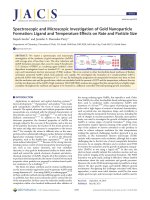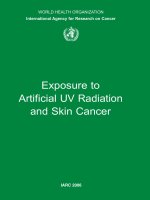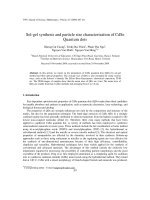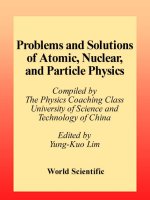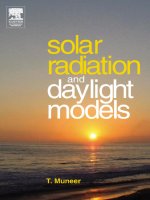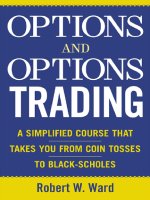radiation and particle detectors [procs., isp course clxxv] - s. bertolucci, et. al., (ios, 2010) ww
Bạn đang xem bản rút gọn của tài liệu. Xem và tải ngay bản đầy đủ của tài liệu tại đây (6.47 MB, 203 trang )
SOCIET
`
A ITALIANA DI FISICA
RENDICONTI
DELLA
SCUOLA INTERNAZIONALE DI FISICA
“ENRICO FERMI”
CLXXV Corso
acuradiS. Bertolucci e U. Bottigli
Direttori del Corso
edi
P. Oliva
VARENNA SUL LAGO DI COMO
VILLA MONASTERO
20 – 25 Luglio 2009
Rivelatori per radiazione
e particelle
2010
SOCIET
`
A ITALIANA DI FISICA
BOLOGNA-ITALY
ITALIAN PHYSICAL SOCIETY
PROCEEDINGS
OF THE
INTERNATIONAL SCHOOL OF PHYSICS
“ENRICO FERMI”
Course CLXXV
edited by S. Bertolucci and U. Bottigli
Directors of the Course
and
P. Oliva
VARENNA ON LAKE COMO
VILLA MONASTERO
20 – 25 July 2009
Radiation and Particle
Detectors
2010
AMSTERDAM, OXFORD, TOKIO, WASHINGTON DC
Copyright
c
2010 by Societ`a Italiana di Fisica
All rights reserved. No part of this publication may be reproduced, stored in a retrieval
system, or transmitted, in any form or any means, electronic, mechanical, photocopying,
recording or otherwise, without the prior permission of the copyright owner.
ISSN 0074-784X (print)
ISSN 1879-8195 (online)
ISBN 978-1-60750-630-0 (print) (IOS)
ISBN 978-1-60750-631-7 (online) (IOS)
ISBN 978-88-7438-058-9 (SIF)
LCCN 2010934193
Production Manager Copy Editor
A. Oleandri M. Missiroli
jointly published and distributed by:
IOS PRESS
Nieuwe Hemweg 6B
1013 BG Amsterdam
The Netherlands
fax: +31 20 620 34 19
SOCIET
`
A ITALIANA DI FISICA
Via Saragozza 12
40123 Bologna
Italy
fax: +39 051 581340
Distributor in the UK and Ireland
Gazelle Books Services Ltd.
White Cross Mills
Hightown
Lancaster LA1 4XS
United Kingdom
fax: +44 1524 63232
Distributor in the USA and Canada
IOS Press, Inc.
4502 Rachael Manor Drive
Fairfax, VA 22032
USA
fax: +1 703 323 3668
Propriet`a Letteraria Riservata
Printed in Italy
Supported by
Istituto Nazionale di Fisica Nucleare (INFN)
INFN, Sezione di Pisa
This page intentionally left blank
INDICE
S. Bertolucci, U. Bottigli and P. Oliva –Preface pag. XI
GruppofotograficodeipartecipantialCorso XVI
P. Oliva –Detectorsformedicalphysics XIX
G. A. P. Cirrone, G. Cuttone, F. Di Rosa, P. Lojacono, V. Mon-
gelli, S. Pittera, L. M. Valastro, S. Lo Nigro, L. Raffaele, V.
Salamone, M. G. Sabini, R. Cirio and F. Marchetto – Detectors for
hadrontherapy 1
1. Introduction 2
2. Irradiation configuration . 2
2
.
1. Absolutedosedetermination: beamcalibration 2
2
.
2. Depthdosedistribution 3
2
.
3. Lateraldosedistribution 3
3. Detectorsforrelativedosimetry 3
3
.
1. Depthdosereferencedetectors 3
3
.
2. Referencedetectorsfortransversaldose 3
4. Relativedetectors 4
4
.
1. NaturalandCVDdiamond 4
4
.
2. Termoluminescencedetectors(TLD) 4
4
.
3. MOSFETdosimetry 5
4
.
4. MOPI 8
5. Conclusions 8
P. A. Mand
`
o – Detection setups in applications of accelerator-based tech-
niquestotheanalysisofCulturalHeritage 11
Introduction: WhyScienceforCulturalHeritage? 11
IonBeamAnalysis(IBA) 12
QuantitativePIXE 14
PIXEexternalbeamsetups 21
Externalscanningmicrobeams 25
Measurementofbeamcurrent 26
AcceleratorMassSpectrometry(AMS) 27
VII
VIII indice
G. Gaudio, M. Livan and R. Wigmans –Theartofcalorimetry pag. 31
1. Introduction 31
2. Thephysicsofshowerdevelopment 32
2
.
1. Electromagneticshowers 32
2
.
2. Hadronicshowers 36
2
.
3. Lessonsforcalorimetry 39
3. The calorimeter response function . 41
3
.
1. Absoluteresponseandresponseratios 41
3
.
2. Compensation 45
3
.
3. Fluctuations 47
3
.
4. The shape of the response function 52
3
.
5. Lessonsforcalorimeterdesign 55
4. Thefutureofcalorimetry 57
4
.
1. Theenergyflowmethod 58
4
.
2. Off-linecompensation 58
4
.
3. Dual-readoutcalorimetry 59
5. TheDREAMproject 60
5
.
1. Measurementoftheneutronfraction 64
5
.
2. Dual-readoutwithcrystals 67
5
.
2.1. Leadtungstatecrystals 69
5
.
2.2. Doped PbWO
4
crystals 71
5
.
2.3. BGOcrystals 72
5
.
3. Combinedcalorimetry 74
6. Outlook 76
M. Mulders –TheCMSdetector 79
1. Introduction
79
2. TheCMSdetector 80
3. PrecisemappingofthecentralCMSmagneticfieldusingprobes 84
4. Precise mapping of the CMS magnetic field in the yoke using cosmic muons 86
5. OthercommissioningresultswithcosmicmuonsfromCRAFT 93
6. FirstCMSphysicsmeasurementwithcosmicmuons 94
7. Observation of the first beam-induced muons 99
8. Prospects for first physics with collisions 101
9. Summaryandconclusion 101
J. Marque for the Virgo Collaboration – A gravitational wave detector:
TheVirgointerferometer
105
1. Gravitationalwaves(GWs) 106
1
.
1. Firstevidence 106
1
.
2. Sourcesofgravitationalwaves 106
1
.
3. Compactbinaries 107
1
.
4. Supernovae 107
1
.
5. Pulsar 107
1
.
6. Stochasticbackground 107
1
.
7. Usinggravitationalwavestostudytheuniverse 108
indice IX
2. TheVirgoexperiment pag. 108
2
.
1. TheVirgoproject 108
2
.
2. Gravitational-wavesstrengthandpolarization 108
2
.
3. TheMichelsoninterferometer 109
2
.
4. Sensitivityrequirement 109
2
.
5. Groundvibrations 109
2
.
6. Superattenuator
110
2
.
7. Thelaser 111
2
.
8. TheamplifierandPre-ModeCleaner 111
2
.
9. Electro-opticmodulators 111
2
.
10. Beamgeometryfluctuations 111
2
.
11. Input Mode Cleaner cavity . . 112
2
.
12. Frequencynoise 112
2
.
13. TheFaradayisolator
112
2
.
14. Residualgas 113
2
.
15. Themirrors 113
2
.
16. Thecoatings 113
2
.
17. Thermalnoise 113
2
.
18. Thermallensingcompensation 113
2
.
19. Shotnoise 113
2
.
20. Opticalscheme
114
2
.
21. Controls 114
3. Othergravitationalwavesdetectors 115
3
.
1. Resonant-massdetectors 115
3
.
2. TheLIGOdetectors 116
3
.
3. TheGEOdetector 116
3
.
4. Spaceinterferometers 116
3
.
5. Pulsartiming
116
4. Performancesofgravitationalwavesdetectors 117
4
.
1. Resonant-massdetectors 117
4
.
2. Horizon 117
4
.
3. Dutycycle 119
5. Futurechallenges 119
5
.
1. Future of ground-based interferometers . 119
5
.
2. AdvancedVirgo 120
5
.
3. Somelimitations 120
5
.
4. Futurebeams 120
5
.
5. Quantumnoise 121
5
.
6. Gravitygradientnoise 121
5
.
7. EinsteinTelescope 121
6. Conclusion 121
G. Riccobene and P. Sapienza – Underwater/ice high-energy neutrino
telescopes 123
1. TheCosmic-Rayspectrum 124
2. Thehigh-energygamma-neutrinoconnection 128
3. High-energyneutrinodetection 131
4. Underwater/ice
ˇ
Cerenkovtechnique 133
X indice
4
.
1. Sourcesofbackground pag. 138
5. Statusofneutrinotelescopeprojects 140
5
.
1. Baikal 140
5
.
2. AMANDA 142
5
.
3. IceCube 142
5
.
4. NESTOR 146
5
.
5. ANTARES 148
5
.
6. NEMO 150
5
.
7. KM3NeT: towards a km
3
scale detector in the Mediterranean Sea . . 153
6. UltraHighEnergyneutrinodetection 156
6
.
1. Thethermo-acoustictechnique 156
7. Conclusions 161
Elencodeipartecipanti 167
Preface
From the 20th to 25th of July 2009 the International School of Physics entitled
“Radiation and Particle Detectors” was held in Varenna, which involved the use of detec-
tors for the research in fundamental physics, astro-particle physics, and applied physics.
At the school ten teachers and thirty students were present.
In the context of fundamental physics the High Energy Physics (HEP) plays an im-
portant role. In general the HEP experiments make use of sophisticated and massive
arrays of detectors to analyze the particles which are produced in high-energy scattering
events. This aim can be achieved in a large variety of approaches. Some examples are
the following:
– Measuring the position and length of ionization trails. Much of the detection
depends upon ionization.
– Measuring time of flight permits velocity measurements.
– Measuring radius of curvature after bending the paths of charged particles with
magnetic fields permits measurement of momentum.
– Detecting Cherenkov radiation gives some information about energy, mass.
– Measuring the coherent “transition radiation” for particles moving into a different
medium.
– Measuring synchrotron radiation for the lighter charged particles when their paths
are bent.
– Detecting neutrinos by steps in the decay schemes which are “not there”, i.e.,using
conservation of momentum, etc. to imply the presence of undetected neutrinos.
– Measuring the electromagnetic showers produced by electrons and photons by
calorimetric methods.
XI
XII Preface
– Measuring nuclear cascades produced by hadrons in massive steel detectors which
use calorimetry to characterize the particles.
– Detecting muons by the fact that they penetrate all the calorimetric detectors.
All these types of detectors are used in the largest accelerator ever built: the Large
Hadron Collider (LHC). LHC is a proton-proton (also ions) ring, 27 km long, 100 m under-
ground, with 1232 superconducting dipoles 15 m long at 1.9 K producing a magnetic field
of 8.33 T. The figures of merit, for proton-proton operations, are beam-energy 7 TeV
(7 × TEVATRON), luminosity 10
34
cm
−2
s
−1
(> 100 × TEVATRON), bunch spacing
24.95 ns, particles/bunch 1.1 · 10
11
, and stored emergy/beam 350 MJ. For ion-ion opera-
tions we will have energy/nucleon 2.76 TeV/u, and total initial luminosity of 10
27
cm
−2
s
−1
.
The main four experiments are two general purpose experiments (ATLAS and CMS), B-
physics and CP violation experiment (LHCB), and heavy ions experiment (ALICE).
The international community of physicists hopes that the LHC will help answer many
of the most fundamental questions in physics: questions concerning the basic laws gov-
erning the interactions and forces among the elementary particles, the deep structure of
space and time, especially regarding the intersection of quantum mechanics and cosmol-
ogy, where current theories and knowledge are unclear or break down altogether. The
enormous success of the Standard Model (SM), tested at per mil level with all particles
discovered except the Higgs boson, will hopefully be able to build a Cosmology Standard
Model.
The issues of LHC physics include, at least:
– Is the Higgs mechanism for generating elementary particles masses via electroweak
symmetry breaking indeed realised in nature? It is anticipated that the collider will
either demonstrate or rule out the existence of the elusive Higgs boson, completing
(or refuting) the SM.
– Is supersymmetry, an extension of the SM and Poincar´e symmetry, realised in
nature, implying that all known particles have supersimmetric partners?
– Are there extra-dimensions, as predicted by various models inspired by string the-
ory, and can we detect them?
– What is the nature of the Dark Matter which appears to account for 23% of the
mass of the universe?
Other questions are:
– Are electromagnetism, the strong force, and the weak interaction just different
manifestations of a single unified force, as predicted by various Grand Unification
Theories (GUTs)?
– Why is gravity so many orders of magnitude weaker than the other three funda-
mental interctions (Hierarchy Problem)? For all proposed solutions: new particles
should appear at TeV scale or below.
Preface XIII
– Are there additional sources of quark flavours, beyond those already predicted
within the Standard Model?
– Why are there apparent violations of the symmetry between matter and antimatter
(CP violation)?
– What was the nature of the quark-gluon plasma in the early universe (ALICE
experiment)?
Obviously, for the construction of a Standard Cosmology Model, the astro-particle ex-
periments are crucial with direct or indirect dark matter measurements. In particular, the
Payload for Antimatter Matter Exploration and Light-nuclei Astrophysics (PAMELA)
experiment, which went into space on a Russian satellite launched from the Baikonur
cosmodrome in June 2006, uses a spectrometer —based on a permanent magnet cou-
pled to a calorimeter— to determine the energy spectra of cosmic electrons, positrons,
antiprotons and light nuclei. The experiment is a collaboration between several Italian
institutes with additional participation from Germany, Russia and Sweden. PAMELA
represents a state of the art of the investigation of the cosmic radiation, addressing the
most compelling issues facing astrophysics and cosmology: the nature of the dark matter
that pervades the universe, the apparent absence of cosmological antimatter, the origin
and evolution of matter in the Galaxy. PAMELA, a powerful particle identifier using a
permanent magnet spectrometer with a variety of specialized detectors, is an instrument
of extraordinary scientific potential that is measuring with unprecedented precision and
sensitivity the abundance and energy spectra of cosmic rays electrons, positrons, an-
tiprotons and light nuclei over a very large range of energy from 50 MeV to hundreds
GeV, depending on the species. These measurements, together with the complementary
electromagnetic radiation observation that will be carried out by AGILE and GLAST
space missions, will help to unravel the mysteries of the most energetic processes known
in the universe. Recently published results from the PAMELA experiment have shown
conclusive evidence of a cosmic-positron abundance in the 1.5–100 GeV range. This
high-energy excess, which they identify with statistics that are better than previous ob-
servations, could arise from nearby pulsars or dark matter annihilation. Such a signal
is generally expected from dark matter annihilations. However, the hard positron spec-
trum and large amplitude are difficult to achieve in most conventional WIMP models.
The absence of any associated excess in antiprotons is highly constraining on any model
with hadronic annihilation modes. The light boson naturally provides a mechanism by
which large cross-sections can be achieved through the Sommerfeld enhancement, as was
recently proposed. Depending on the mass of the WIMP, the rise may continue above
300 GeV, the extent of PAMELA’s ability to discriminate electrons and positrons. The
data presented include more than a thousand million triggers collected between July
2006 and February 2008. Fine tuning of the particle identification allowed the team to
reject 99.9% of the protons, while selecting more than 95% of the electrons and positrons.
The resulting spectrum of the positron abundance relative to the sum of electrons and
positrons represents the highest statistics to date. Below 5 GeV, the obtained spectrum
XIV Preface
is significantly lower than previously measured. This discrepancy is believed to arise from
modulation of the cosmic rays induced by the strength of the solar wind, which changes
periodically through the solar cycle. At higher energies the new data unambiguously
confirm the rising trend of the positron fraction, which was suggested by previous mea-
surements. This appears highly incompatible with the usual scenario in which positrons
are produced by cosmic-ray nuclei interacting with atoms in the interstellar medium.
The additional source of positrons dominating at the higher energies could be the sig-
nature of dark matter decay or annihilation. In this case, PAMELA has already shown
that dark matter would have a preference for leptonic final states. They suggest that
the alternative origin of the positron excess at high energies is particle acceleration in
the magnetosphere of nearby pulsars producing electromagnetic cascades. The members
of the collaboration state that the PAMELA results presented here are insufficient to
distinguish between the two possibilities. They seem, however, confident that various
positron production scenarios will soon be testable. This will be possible once additional
PAMELA results on electrons, protons and light nuclei are published in the near future,
together with the extension of the positron spectrum up to 300 GeV thanks to ongoing
data acquisition.
S. Bertolucci, U. Bottigli and P. Oliva
This page intentionally left blank
Società Italiana di Fisica
SCUOLA INTERNAZIONALE DI FISICA «E. FERMI»
CLXXV CORSO - VARENNA SUL LAGO DI COMO
VILLA MONASTERO 20 - 25 Luglio 2009
1) A. Agostinelli
2) D. Caffarri
3) A. Junkes
4) F. Bellini
5) B. Guerzoni
6) V. Cavaliere
7) L. Caforio
8) A. Silenzi
9) M. Siciliano
10) D. Fasanella
11) M. Nocente
12) M. Bettuzzi
13) P. Allegrini
14) P. Bennati
15) A. Di Canto
16) F. Sforza
17) M. V. Siciliano
18) F. Albertin
19) P. Garosi
20) G. Volpe
21) L. Velardi
22) J. Lange
23) D. Lattanzi
24) L. Soung Yee
25) E. Gurpinar
26) G. Sabatino
27) M. Endrizzi
28) S. Tangaro
29) B. Alzani
30) R. Brigatti
1
31) L. Strolin
32) P. Oliva
33) J. Marque
34) M. Mulders
35) U. Bottigli
36) G. Riccobene
2
3
4
5
6
7
8
9
10
11
12
13
14
15
16
17
18
19
20
21
22
23
24
25
26
28
27
29
30
31
32
33
34
35
36
This page intentionally left blank
Detectors for medical physics
Notes from the lecture of Maria Giuseppina Bisogni
Universit`a di Pisa, Dipartimento di Fisica “E. Fermi”
and INFN Sezione di Pisa - Pisa, Italy
A straightforward application of detection technologies developed in high-energy physics
is medical imaging.
Two main fields of medical imaging have to be covered by these detectors: morpho-
logical imaging and functional imaging. And the most used radiation type are X-rays or
gamma rays.
Since the beginning of morphological imaging the most used detector has been the
screen-film system. However, in the recent years digital detectors have become more and
more important. Digital imaging has several advantages with respect to conventional
imaging: the images can be displayed, stored and processed by a computer and can
be easily transferred from one site to another. Moreover digital detectors have a wider
dynamic range so the exposure is a less critical factor.
Digital detection can be performed in a direct on in an indirect way: in the first case
the radiation interacts directly with the detector, while in the second case it interacts
with a scintillator and the light produced in it is then detected by the digital detector.
A first example of digital detectors for medical imaging are Charge Coupled Devices
(CCD). They are based on the technology Metal Oxide Semiconductor (MOS). The
charge produced is stored in a potential well. The potential changes to make the charges
shift from one pixel to the next in a given column and there is a serial read-out with a
clock.
CCDs are generally coupled to scintillators CsI(Tl) to improve efficiency, so they are
indirect digital detectors.
Widely used indirect digital detectors are a-Si Flat Panels. They are made of a-Si:H
photodiodes (low dark current, high sensitivity to green light), coupled to CsI phosphors.
In order to improve efficiency by keeping spatial resolution high, the scintillator is made
of CsI:Tl needle crystals: their thickness is about 550 μm, which allows a good X-ray
absorption. The needles act as light guides, leading to a sharp point spread function.
Moreover CsI:Tl emits green light.
Examples of direct digital detection are a-Se Flat Panels. They are made of alloyed
a-Se with % As and with ppm Cl and the detection system is a TFT.
XIX
XX Detectors for medical physics
A challenging application of these detectors is digital mammography. In mammogra-
phy the details of interest are very low contrast ones (like tumor masses) or very small
details (like microcalcifications). So mammography is a demanding task for both effi-
ciency and spatial resolution.
A widely used indirect detection system is the GE Senographe 2000D that uses a Flat
Panel Digital Detector Si +CsI(Tl).
The total area covered by the detector is 18 ×24 cm
2
and the pixel is 100 ×100 μm
2
.
Nowadays also direct digital detectors are available (a-Se based flat panels) like Sele-
niaTM, LORAD-Hologic, Mammomat NovationDR Siemens.
A promising alternative to conventional integrating detectors are Single Photon Count-
ing (SPC) Systems. They allow efficient noise suppression, leading to a higher SNR or
lower dose, so they are particularly suited for low-event-rate applications.
They are linear whit exposure and have wider dynamic range (with respect to inte-
gration detectors), limited only by counter saturation.
They can allow an energy discrimination rejecting Compton events or X-ray fluores-
cences.
Also “energy weighting” (low-energy photons weight less than high-energy ones in
integrating systems) is suppressed because in SPC systems all photons have the same
weight.
Sectra MicroDose is the First SPC commercial mammographic system.
The SYRMEP Project (INFN GV, early ’90s) also developed an SPC detector. It
is an Edge-on Si strip detector. A silicon microstrip detector is used in the so-called
“edge-on” geometry matching the laminar geometry of the beam. The absorption length
seen by the impinging radiation is given by the strip length (∼ 100% in 1 cm of silicon
for 20 keV photons). There is almost complete scattering rejection. The pixel size is
determined by the strip pitch (H) times the detector thickness (V ). A drawback is that
the dead volume in front of the strip reduces the efficiency of the detector.
The Integrated Mammographic Imaging Project (IMI) is a collaboration between na-
tional universities, INFN and Industry which developed a mammography system demon-
strator based on GaAs pixel detectors. Photoelectric interaction probability is about
100% in the mammographic energy range (10–30 keV) for a 200 μm thick GaAs crystal.
So the detector is made of 200 μm thick GaAs bump-bonded to a Photon Counting
Chip (PCC). The detection unit presents a 18 ×24 cm
2
exposure field. A 1D scanning is
performed by 9 ×2 assemblies in 26 exposures and the image is “off-line” reconstructed.
Another application of growing interest in medical imaging is the Computed Tomo-
graphy (CT). This imaging modality is intrinsically related to digital detector, since slice
images have to be reconstructed from actually acquired projection images by a specific
algorithm.
Current CTs are spiral CT, that acquire the whole volume of interest in a single
exposure by rotating continuously both the source and the detectors while the patient is
moving along his axial direction. By using multiple arrays of detectors it is now possible
to acquire more than one slice simultaneously. Modern systems can acquire up to 256
Detectors for medical physics XXI
differentslicesatthesametime.ThefutureofCTistheconebeamCTwithafullarea
detector, which will allow acquisition of large areas in a very small time.
Micro Computed Tomography is a technique for small fields of measurement (typically
5–50 mm). It is characterized by very-low-power X-ray sources (typically 5–50 W) and
long scan times (typically 5–30 minutes). It is devoted to the imaging of a specific organ
(bone, teeth, vessels, cancer) or to the imaging of samples (biopsies, excised materials)
or small animals (rats/mice) in vivo, ex vivo or in vitro.
Functional imaging is dedicated to the in vitro or in vivo measure of the intensity
of functional/metabolic processes occurring within a living body. Nuclear medicine uses
molecules or drugs marked with radioisotopes (radiotracer) for this kind of imaging.
The principle of radiotracer applications is that changing an atom in a molecule for
its radioisotope will not change its chemical and biological behavior significantly. As a
consequence, the movement, distribution, concentration of the molecule can be measured
by radiation detectors.
The two main imaging modalities used in nuclear medicine are SPECT (Single Photon
Emission CT) and PET (Positron Emission Tomography).
In SPECT the radiotracer emits one photon (for example
99m
Tc, while in PET two
anticollinear photons are emitted by positron annihilation.
The main detector used in SPECT is the Gamma Camera, that is made of a Pb
collimator (that encodes the spatial information), a NaI (Tl) scintillation crystal and an
array of PMTs connected to amplifiers and positional logic circuits.
The principle is that many photomultiplier tubes “see” the same large scintillation
crystal; an electronic circuit decodes the coordinates of each event.
γ-rays (typically: 140 keV from
99m
Tc) are emitted in all directions hence collimators
are required to determine the line of response. To perform a CT, in SPECT scanners
rotate around the patient.
In PET a tracer containing a β
+
emitting isotope is used. The emitted positron
annihilates in a short range (∼ 1 mm) emitting two antiparallel photons of 511 keV.
The signal detection is based on the coincidence detection at 180
◦
, leading to a higher
sensitivity and a better signal/noise ratio than SPECT.
Detectors are usually scintillators coupled to a read-out device (typically a photomul-
tiplier, PMT), which can be arranged in a ring geometry or in a parallel-plate geometry.
Detectors are usually scintillators: the most often used is BGO (bismuth germanate,
Bi
4
Ge
3
O
12
) and more recently LSO (lutetium oxi-orto silicate, LuSiO).
In a block detector conventionally used in PET, a 2D array of crystals is attached
to 4 PMTs. Usually the array will be cut from a single crystal and the cuts filled with
light-reflecting material. When a photon is incident on one of the crystals, the resultant
light is shared by all 4 PMTs. Information on the position of the detecting crystal may
be obtained from the PMT outputs comparing them to pre-set values.
For more than 80 years, the PMT is the photodetector of choice to convert scintilla-
tion photons into electrical signals in most of the applications related to the radiation
detection. This is due to its high gain, low noise and fast response. Research is now
XXII Detectors for medical physics
moving to solid-state photodetectors that show the following advantages with respect to
PMTs:
– Compactness
– High quantum efficiency (to provide an energy resolution comparable to PMTs)
– Insensitivity to magnetic fields (PET/MRI)
TOF-PET (Time-of-Flight PET) systems exploit the time difference between the two
emitted photons to better locate the annihilation position. The limit in the annihilation
point location is mainly due to the error in the time difference measurement, namely the
time resolution Δt of the coincidence system. Time resolution is used by the reconstruc-
tion algorithm to locate the annihilation point Δx (Δx = cΔt/2).
Extensive work on TOF PET was done in the ’80s and several TOF PET cameras
were built and most of the advantages described here were experimentally verified.
But the scintillator materials used in the ’80s (BaF
2
and CsF) had drawbacks (e.g.,
low density, low photofraction) which required other performance compromises, so BGO
dominated PET. Nowadays new scintillating materials like LSO (∼ 200 ps) and LaBr
3
(< 100 ps) can provide outstanding timing resolution without other performance com-
promises, so TOF PET is experiencing a rebirth.
Simultaneous PET-CT systems are now available. PET needs CT data to anatom-
ically locate the tumor and to correct for the attenuation in order to provide a correct
quantification. Present systems exploit multislice CT top quality systems, where the
number of slices can reach 128 with rotation time of the order of 300 ms. Being the
attenuation coefficients (μ) energy dependent, the CT scanning at an average energy of
70 keV must be rescaled (voxel by voxel) to the gamma rays by using a bi-linear scaling
function.
Synchronization of PET-CT acquisitions with breath cycle minimizes motion effects
but limits the data statistics thus ultimately increasing the noise in the final image. The
use of non-rigid registrations (NRR) among gated-PET images leads to high-quality,
low-noise motion-free PET images.
An interesting alternative to PET-CT systems are PET-MR (PET and Magnetic
Resonance) systems which allow to combine function (PET) and anatomy and function
(MR). However there are technical challenges in realizing PET/MR systems. There is
interference on PET photomultiplier and electronics due to the static magnetic field and
to the RF and the gradient fields. There are also interferences on MR homogeneity
and gradients due to electromagnetic radiation from PET electronics, in maintaining
magnetic-field homogeneity. Moreover PET attenuation correction via MR data is a
challenge.
Regarding the optimal detection system for PET in PET-MR systems, two differ-
ent approaches are under investigation: scintillating crystals plus photomultiplier tubes
(PMT) or scintillating crystals plus solid-state light detectors. PMTs are well under-
stood, have stable electronics and high gain (10
6
). However, Position Sensitive PMT
Detectors for medical physics XXIII
(PSPMT) operate in magnetic fields of 1 mT. A combination of distance (light guide)
and iron shield (1–2 mm of soft iron can further reduce 30 mT → 1 mT) is used to allow
PSPMT to operate in 1 mT. 1 mT has minimal effect on PSPMT performance. How-
ever long light guides reduce the energy resolution from 17 to 27%, but this should not
have too big an impact upon performance. Simultaneous and isocentric MR/PET mea-
surements can be performed. However, this system presents a small axial field of view
(FOV).
The alternative to PMTs are solid-state devices, like Avalanche Photodiodes (gain
∼ 150), Silicon Photomultiplier (gain ∼ 10
6
). They are less well established than PET
detectors, but can operate in high static field greater than 7 T. However, there is still the
need to shield devices from both gradients and RF.
P. Oliva
This page intentionally left blank
Proceedings of the International School of Physics “Enrico Fermi”
Course CLXXV “Radiation and Particle Detectors”, edited by S. Bertolucci, U. Bottigli and P. Oliva
(IOS, Amsterdam; SIF, Bologna)
DOI 10.3254/978-1-60750-630-0-1
Detectors for hadrontherapy
G. A. P. Cirrone, G. Cuttone, F. Di Rosa, P. Lojacono, V. Mongelli,
S. Pittera and L. M. Valastro
INFN, Laboratori Nazionali dei Sud - Catania, Italy
S. Lo Nigro
Dipartimento di Fisica ed Astronomia, Universit`a di Catania - Catania, Italy
L. Raffaele and V. Salamone
A.O.U. Policlinico, Universit`a di Catania - Catania, Italy
M. G. Sabini
A.O. Cannizzaro - Catania, Italy
R. Cirio and F. Marchetto
Universit`a di Torino e INFN, Sezione di Torino - Torino, Italy
Summary. — Proton therapy represents the most promising radiotherapy tech-
nique for external tumor treatments. At Laboratori Nazionali del Sud of the Istituto
Nazionale di Fisica Nucleare (INFN-LNS), Catania, Italy, a proton therapy facility
is active since March 2002 and 200 patients, mainly affected by choroidal and iris
melanoma, have been successfully treated. Proton beams are characterized by higher
dose gradients and linear energy transfer with respect to the conventional photon
and electron beams, commonly used in medical centers for radiotherapy. In this pa-
per, we report the experience gained in the characterization of different dosimetric
systems, studied and/or developed during the last ten years in our proton therapy
facility.
c
Societ`a Italiana di Fisica 1
